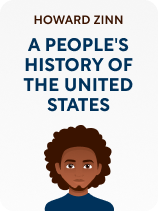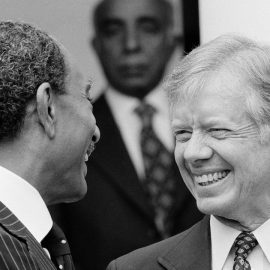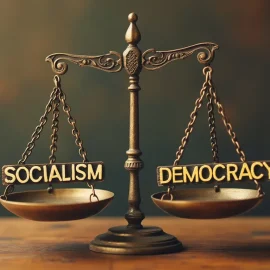

This article is an excerpt from the Shortform book guide to "A People's History of the United States" by Howard Zinn. Shortform has the world's best summaries and analyses of books you should be reading.
Like this article? Sign up for a free trial here.
How well do you know American history? Have you been exposed to all sides of it?
A People’s History of the United States by Howard Zinn provides a bottom-up view of American history focusing on Indigenous people, Black Americans, women, laborers, and activists. In doing so, he shares an alternative perspective of significant events, themes, and historical trends in American history.
Continue reading for a comprehensive overview of this major undertaking.
Howard Zinn’s A People’s History of the United States
Conventional accounts of American history tend to focus on the people at the top—presidents, generals, CEOs, and other influential figures—and their struggles, ambitions, hopes, and dreams. But, what about average people—those who had to live with the consequences of elite decisions, and who often struggled in obscurity? A People’s History of the United States by Howard Zinn aims to tell their story. He looks past elite ideals and rhetoric to examine the harsh economic realities behind their decision-making while also examining how popular movements responded to or resisted those decisions.
(Shortform note: Zinn’s method of analyzing history is similar to historical materialism, an analytical theory developed by Karl Marx and Friedrich Engels in the mid-19th century. According to historical materialism, social structures, behaviors, and key historical decisions are all determined by economic factors—specifically the distribution of wealth and goods, and the capacity to create them. Unlike a pure historical materialist analysis, though, Zinn’s history acknowledges the importance and influence of cultural moods and ideological beliefs alongside economic factors.)
We’ll explore Zinn’s analysis of American history in five parts:
- Part 1: The Colonial Era (1492-1788) discusses the exploitative class structure of colonies in America and how the founding of the United States preserved the status quo.
- Part 2: Expansion and Division (1789-1865) outlines the violent process of US westward expansion and how it eventually led to the American Civil War.
- Part 3: Industry and Labor (1840-1939) explores the human toll of industrialization and how workers organized to fight for better conditions.
- Part 4: Rising Empire (1898-1972) explains how the US became the world’s dominant imperial power and the consequences of this transformation.
- Part 5: Social Upheaval and the Modern Consensus (1945-2001) describes social movements of the ’60s and ’70s as well as the political consensus that emerged afterward.
Part 1: The Colonial Era (1492-1788)
Zinn begins with a brief overview of European colonialism in the Americas to provide context for the founding of the US.
In Part 1, we’ll outline why this colonial project started, how it functioned, and the circumstances that eventually changed a group of colonies into the US.
Colonial Ambition and Christopher Columbus
Colonialism was the result of the development of capitalism—an economic system in which people compete to accumulate as much private property as possible—in Europe, explains Zinn. Under this new system, individuals and nations constantly sought new sources of wealth. This search eventually led European colonists to the Americas: resource-rich continents full of cultures and peoples without the military technology or cutthroat competitive economic systems of Europe.
Starting with Christopher Columbus in 1492, European colonists engaged in a pattern of conquest, genocide, and enslavement of Indigenous peoples throughout the Americas with the goal of getting rich. Not all colonists were vicious all of the time, but exploitation and bloodshed were the driving force during this period of history.
The Classes of Colonial America
Through the 17th and 18th centuries, British elites established a number of colonies in North America. These colonies functioned according to a hierarchical class system with wealthy white men on top:
- Financiers, aristocrats, and merchants in Britain invested in—and extracted as much resource wealth as possible from—the colonies.
- Elites in the colonies themselves managed the harvest and sale of resources, owning a majority of colonial farmland and manufacturing facilities.
- A middle class of skilled laborers and small landholders made less than elites, but enough to live independently.
- Poor white laborers and farmers worked directly for American elites, while slaves and American Indians had few or no rights or property.
Zinn discusses the experience of the people within this system’s lower class and how they tried to improve their circumstances:
Slaves: Displaced and Exploited
Enslaved Africans (and in future generations, African-Americans) provided a large force of free labor that was crucial for the early survival and profitability of the American colonies, explains Zinn. He argues that while ideas of white racial superiority and racism existed before the slave trade, they became widespread and dominant because of it.
Slavery existed in Africa before Europeans arrived, but on a smaller scale and under less brutal conditions. Under capitalism, though, slavery became a massive and horrific industry. Slaves were kidnapped (usually in West Africa), separated from their cultures and communities, then shipped in horrible conditions to be exploited for the rest of their lives. They had no rights and no property; white colonists often tortured, raped, and killed them with no repercussions.
Elites promoted white supremacy and racism to justify the slave trade and to sow division between poor whites and Black slaves—they feared that these two groups working together could overthrow the colonial class system. This nearly happened in 1676, Zinn notes, when English colonist Nathaniel Bacon united poor whites and Black slaves to revolt against the colonial government. After quelling the rebellion, colonial elites passed a number of “slave codes” formalizing race-based segregation to prevent a similar event from happening again. Without the option of revolt, some enslaved people resisted oppression through working slowly, sabotaging the workplace, suicide, murdering slave owners, or running away.
Poor Whites: Trying to Get By
Poor white European colonists served two main purposes for elites in the colonial class system:
1) Laborers: Instead of owning property, many poor whites worked for elites. Their work took several forms: Some were indentured servants, working for a set number of years to regain their freedom. Others worked as tenant farmers, renting land from elites to farm. Still others worked for wages in elites’ factories. Regardless of what they did, all laborers worked under unpleasant conditions—enduring abuse, low pay, and little economic mobility.
2) Frontiersmen: Some poor whites went west to the frontier, fighting American Indians for their land to escape poverty. This served as a form of social control by elites—it allowed poor whites to act as a “buffer” between the Indians and the elites, while also ensuring poor whites on the frontier saw Indians, not the exploitative elites, as the main obstacle to financial security.
Women: Kept Separate and Below
Zinn argues that because European society was based on accumulating private property, there were economic incentives for men to treat women as unpaid servants and childbearers—especially since more children meant more available labor. As a result, women in the colonial era were kept from political and economic capital regardless of their class position.
Women were kept in the household, unable to own property, collectively organize with other women to demand fairer treatment, or exercise control over their lives or legal rights. Rape and other forms of abuse were common, and usually went unpunished—especially when enslaved or American Indian women were the victims. Despite this, women still fought for equality; middle- and upper-class women argued and wrote on behalf of women’s rights, while poor women in factories organized walkouts and strikes for better working conditions.
The American Revolution (1765-1783)
While the colonial class system successfully repressed lower-class revolt, it didn’t stop elites from competing with one another. As such, Zinn argues that the American Revolution was a conflict between British and American elites, not a popular uprising. In the years leading up to the war, American elites had two significant problems:
- Increased British taxes and tariffs were cutting into their profits.
- Class tension was growing among poor whites throughout the mid-18th century over horrible living and working conditions and low pay. Isolated revolts, riots, and rebellions became common: tenant farmers collectively refusing to pay rent, angry mobs storming stores and warehouses for food, and so on.
The American Revolution allowed American elites to address both of these problems: They recruited poor whites to fight the British instead of resisting the colonial class system. While many middle class and elite Americans believed in the ideals of the revolution—such as popular government and universal rights—they ultimately fought for their own benefit, not for any major redistribution of power or wealth between classes. The other classes were ambivalent about the war: Poor whites were either conscripted or joined the war because they needed money. Slaves mainly fought for Britain, who promised freedom in exchange for service. Indians also mostly fought for the British, as they had halted westward expansion.
Forming the US
After the colonists—aided in large part by the French—forced Britain to withdraw, they formally established the US in 1776. However, when it became clear there weren’t going to be major changes to the distribution of wealth, the same pre-war class tensions returned. Zinn explains that failures to pay Revolutionary War veterans their due wages, new taxes on the poor, and a weak government caused uprisings that threatened to destroy the power of the American elite.
It was in this context that a group of almost entirely white elite men came together to draft the US Constitution. They designed the document to secure their own class position, while conceding just enough power to the middle class to create a broader base of support. The Constitution did this through a number of systems: For example, it created a Supreme Court of justices appointed for life by the president instead of being elected. This ensured they didn’t have to be accountable to the electorate. In addition, the US Constitution distributed Senators equally among states rather than by population, which skewed power away from majority rule.
Part 2: Expansion and Division (1789-1865)
Following his discussion of the colonial era and the founding of the US, Zinn turns his attention to the first half of the 19th century. Part 2 covers his discussion of the country’s economic and territorial expansion during this period, and how it led to the displacement of American Indians, the Mexican-American War, and the American Civil War.
Expansion of Territory
The US made its largest territorial gains during the first half of the 19th century as the frontier pushed west. Zinn focuses primarily on two conflicts that arose from this massive rate of expansion: Indian removal and the Mexican-American War.
Indian Removal
During its westward expansion, the US conducted a policy of Indian removal, or the displacement and ethnic cleansing of American Indian tribes. The US carried out Indian removal through violence, exploitative treaties, and encouraging tribes to turn against one another to weaken resistance. Unlike during the colonial era, the main beneficiaries of Indian removal during the US’s expansion weren’t poor white frontiersmen. Instead, wealthy land speculators or railroad companies collaborated with the government, buying land that the US forced Indians off of. Then, they profited by developing the land, renting it out to poor farmers, or selling it for a higher price.
Indian removal policies were devastating economically, physically, and spiritually to Indian tribes. Many had lived off of their land for generations, accumulating knowledge of the area as well as cultural and religious ties to it. Once displaced, they often had to change their way of life—going from a hunting-based lifestyle to an agricultural lifestyle, for example—in an unfamiliar region. Many tribes resisted Indian removal in a number of ways, through violence, attempts to assimilate and integrate into American culture and life, or even legal means. While some of these attempts were met with limited or temporary success, none were able to stop or even significantly slow the process of Indian removal.
For example, in the Supreme Court case Worcester v. Georgia, the Cherokee Indian tribe fought to hold onto their land in Georgia. Although they won the case and the right to stay, President Andrew Jackson and the Georgia state government ignored the ruling. Not long after, the US government ethnically cleansed the Cherokee tribe, forcing them to march along the “trail of tears” to Oklahoma. Thousands died on the journey from cold, starvation, and disease.
The Mexican-American War (1846-1848)
Zinn argues the Mexican-American War was a conflict between exploitative elites over territory. As the US expanded west via Indian removal, some politicians began eyeing the neighboring territory of Mexico. The US annexed the breakaway Mexican state Texas in 1845, and then sent troops into Mexican territory to provoke a military response in 1846. When the Mexican army inevitably retaliated, the US declared war.
American soldiers were either impressed into service, or they joined for economic opportunities. While morale started high, it soon plummeted due to brutal conditions—disease was rampant, combat was bloody and chaotic, and promises of wealth turned out to be greatly exaggerated. Desertion was common; so was raping and robbing civilians. In the siege of Vera Cruz, US Naval ships indiscriminately shelled the city, mostly killing civilians, until it surrendered. Eventually, the US forced the Mexican government to surrender, seizing all Mexican territory north of the Rio Grande.
Division: The Civil War (1861-1865)
The rapid expansion of the US rekindled old simmering conflicts over the country’s political and economic future, which eventually culminated in a long, bloody civil war. Zinn argues the American Civil War was caused by conflicting economic interests of Northern and Southern elites. The Northern elite of bankers, merchants, and industrialists wanted an industrial economy, while Southern plantation owners wanted an economy based primarily around agriculture and slave labor.
For decades, this conflict played out in political debates over the expansion of slavery to new states—expanding slavery would mean more pro-slavery congressmen and a larger portion of the economy dedicated to slave agriculture. Northern elites made countless concessions to Southern elites during this era, prioritizing stability over ending slavery. But this conflict ultimately couldn’t be resolved through politics alone. When Abraham Lincoln was elected president on the platform of stopping the expansion of slavery, Southern elites decided to secede from the country and formed the new Confederate States of America. The North, also known as the Union, then went to war to defeat the rebellion and reunify the country.
Impact of the Civil War
Though conflict among the elites caused the Civil War, Zinn explains that the poor fought and paid for it. Hundreds of thousands of poor Americans fought and died on both sides of the conflict as it became much longer and larger than expected. The wealthy, on the other hand, could pay to avoid the draft or hire a substitute to fight for them. Free Blacks and slaves were a decisive factor in the war, Zinn suggests—as many as 200,000 free Blacks and escaped slaves joined the Union army, while slaves within the Confederacy crippled its economy by running away, refusing to work, or turning on their owners.
Despite the invaluable support of Blacks, racism in the North remained common. White civilians and soldiers often harassed their free Black counterparts, while the Union military often sent Black units on suicide missions. Many white Northerners rioted because they were angry about fighting on behalf of Blacks, attacking free Blacks and destroying their property.
Reconstruction
Following the end of the Civil War in 1865, there were many questions about what would happen to ex-Confederate leaders, how the government would redistribute land and wealth seized in the South, and the fate of the newly freed slaves. The process of answering these questions was known as Reconstruction. Zinn argues that questions of wealth and racial equality were linked—without the redistribution of land and wealth, legal rights and citizenship would be insufficient to grant Black Americans equality.
For a time, things seemed hopeful—Northern Republicans had a vested interest in developing Southern Black communities to grant them a new voter base. Under the protection of the Union army, Black political communities formed in the South, electing officials to local, state, and even federal positions. The government established mixed-race public education as well as laws and amendments protecting the rights of Black Americans.
However, the government ultimately returned most of the land and wealth it seized to white ex-Confederates. Some freed slaves pooled their money to buy land, but a majority had little to no property and had to work for former slave owners under harsh conditions for minimal wages. Southern whites organized the Ku Klux Klan and other groups dedicated to terrorizing and destroying Black communities. Eventually, Northern support for Black reconstruction waned in favor of a return to the status quo, and Southern whites were able to effectively ignore the new laws protecting Black rights.
Part 3: Industry and Labor (1840-1946)
Zinn explains that in the decades following the Civil War, the US industrialized at a rapid pace and became a global power—at the expense of American laborers. Part 3 will explore the consequences of industrialization, how American laborers resisted them, and challenges the American labor movement faced.
Industry
Zinn explains that while the US started industrializing early in the 19th century, the process accelerated after the Civil War. Capitalists used their political power as well as violence and corruption to control the government and make massive amounts of wealth. In the meantime, average people suffered. Factory employees worked over 12 hours a day in horrible conditions just to scrape by, then return to their dirty, cramped homes. Accidents were common, disease was rampant in urban slums, and average life expectancy plummeted.
The Labor Movement
In response to their grim conditions, workers organized (illegally at the time) and advocated better working conditions, higher pay, and other benefits. This usually involved striking, or laborers refusing to work until their demands were met. Often, capitalists, police, hired thugs, and sometimes the National Guard attacked and killed strikers. Initially, labor organization was sporadic, small, and rarely effective—employees of one plant would walk off the job in protest only to be replaced by other people looking for work. But over time, it grew in scale and ambition. Zinn notes several important elements of the labor movement: trade unions, socialism, and radical organizers.
1) Trade Unions
Zinn explains that the largest form of labor organization were trade unions: organizations of workers within a specific trade, such as teachers and longshoremen. These unions attempted to monopolize their specific form of labor, then used this monopoly to make demands of their employers.
Trade unions also worked together through larger organizations such as the American Federation of Labor (AFL), founded in 1886. These organizations allowed trade unions to coordinate their strikes across an industry or even across multiple industries, giving them more leverage to make greater demands. But like many of the trade unions it consisted of, the AFL didn’t represent all American workers—Blacks, women, and immigrants couldn’t join for several decades. However, the AFL still fought hard for important rights like shorter working days, better working conditions, and a ban on child labor.
2) Socialists and the Socialist Party of America
Zinn explains that socialism, or the political and economic ideology promoting collective ownership of property, rapidly gained popularity in late 19th and early 20th century America. Socialists came from a number of backgrounds: They were trade unionists, rural populists, idealistic academics, immigrants, and so on. Their politics were anti-war, anti-imperialist, pro-worker’s rights, pro-government regulation, and pro-social safety nets. Socialists made their largest gains under the banner of the Socialist Party of America (or SPA), a political party founded in 1901.
The SPA also overlapped with women’s rights and women’s suffrage groups of the era, though they weren’t totally aligned; socialists tended to prioritize economic causes over social ones. In addition, while the SPA preached racial equality and allowed people of all races to join, it didn’t advocate particularly hard for Black Americans despite it being a dangerous era for them due to white mob lynchings and horrible working conditions.
3) Radicals, Militant Unions, and the IWW
Zinn makes the case that radical organizers were also important for the labor movement. Their violence and serious disruptions to business put large amounts of pressure on capitalists to make concessions. Particularly toward the end of the 19th century under intense economic strain, more radicals emerged. Anarchists like Alexander Berkman and Emma Goldman believed that to achieve the socialist dream of collective ownership, current political and economic systems had to be destroyed. They argued that in the right context, violence—including bombings and assassinations—was appropriate to achieve these ends.
Founded in 1905, Industrial Workers of the World, or IWW, was a militant union accepting all workers regardless of their industry, race, sex, or immigration status. Instead of negotiating contracts with management like trade unions, the IWW traveled the country supporting and organizing massive ‘general strikes’ of all workers in a given area. They didn’t condone violence except in cases of self-defense, but the nature of their cause meant they often clashed with and were heavily persecuted by law enforcement.
The Labor Movement’s Obstacles
Despite the growing size and scale of the American labor movement in the 19th and 20th centuries, Zinn argues progress was still slow and difficult. He notes three significant obstacles of the labor movement: institutional resistance, internal divisions, and moderates.
1) Organized Institutional Resistance
Zinn explains that a majority of institutions in American society worked together against the labor movement. Police, private security, and even the National Guard often used violence to break up strikes and force people back to work. In addition, major newspapers and the judicial system persecuted labor organizers. For example, the first Red Scare (a political purge of the left and moral panic around communism in the early 1920s) led to a coordinated campaign of anti-labor propaganda, mass prosecutions, and violent suppressions of strikes, contributing to the IWW’s loss of power and influence.
2) Internal Divisions
Divides within the labor movement often prevented workers from organizing together, or in some cases, even turned them against one another. These divides were often based on racial, ethnic, or gendered prejudice. For example, a brickyard strike in 1899 in Newburg, New York morphed into a race riot when striking white workers attacked Black workers brought in to cross the picket line. Divisions also occurred along ideological lines—the Socialist Party split in 1919 over whether it would support the newly formed Soviet Union. Pro-Soviet and more radical members left the SPA to form the Communist Party USA, halting the SPA’s growing momentum.
3) Moderates
Zinn argues thelabor movement was alsohampered by moderates channeling time, energy, and money into inadequate reforms. In particular, these moderates often pushed for reform “within the system” via electoral or legislative victories. However, these were insufficient at best and ineffective at worst, Zinn argues, as electoral politics were structurally designed to serve elite interests. For example, the National Labor Union discouraged strikes in favor of lobbying Congress for labor reforms and running candidates in elections. However, their few legislative successes were bypassed with loopholes, and their candidates lost by large margins.
The Great Depression and the New Deal (1929-1939)
Economic and political circumstances of the late ’20s through the ’30s saw significant shifts in the American labor movement, explains Zinn: most significantly, the Great Depression and New Deal.
The Great Depression
The activity and militancy of the American labor movement tended to fluctuate along with the desperation of workers and the state of the economy. Therefore, the Great Depression—a severe economic downturn that began in 1929 and lasted over a decade—caused labor unrest to skyrocket to an all-time high. For the first several years of the depression, elites in business and government had no clue what to do, leaving the American people to fend for themselves. Communists, socialists, and labor activists organized their communities to support one another, engage in massive, citywide strikes, and pressure elites to make concessions.
Some activists didn’t coordinate with Black Americans during the depression—they either weren’t interested or worried that doing so would alienate potential white, working-class supporters. The Communists were one of the few groups who made a serious effort to build a cross-racial coalition during this era, secretly helping black laborers organize themselves.
The New Deal
Concessions to the American public came in the form of the New Deal, a series of laws and social programs under President Franklin Delano Roosevelt designed to help the country recover. However, Zinn argues the New Deal was still ultimately a project by and for elites—it shared just enough wealth and power with the American people to prevent all-out rebellion while centralizing power in the federal government via appointee-only bureaucracies. In addition, the New Deal largely ignored the plight of Black Americans—Roosevelt needed the support of Southern segregationists to pass his desired policies, so he didn’t pursue anti-segregation or anti-lynching measures.
For example, the Wagner-Connery Act in 1935 legalized labor unions and formalized the process of labor-management negotiations. This law provided some concessions to labor—employers could no longer fire workers for being union members, for example. However, it also channeled popular energy away from using strikes to cause broad social change and toward internal union politics and negotiating financially beneficial contracts.
Part 4: Rising Empire (1898-1945)
For centuries, American expansion had been fueled by the frontier—the “free” land and resources of the West provided a way for enterprising capitalists to make and expand their fortunes. But, by the end of the 19th century, Zinn explains, the American frontier had closed. Land and wealth in the US were largely divided up among a select few elites. To continue increasing their wealth, elites had to start influencing and controlling other countries and peoples—they had to make America an empire.
In Part 4, we’ll discuss how and why the US became an empire as well as the growing popular unrest within the country throughout the first half of the 20th century. We’ll also cover how major global events—namely the two World Wars and the Cold War—influenced these trends.
Early Imperial Projects
Around the turn of the 20th century, the US engaged in a number of imperial projects, influencing, controlling, and even conquering other nations and colonies. These accomplished two major goals for elites: First, they created new markets for American goods and new sources of cheap labor and natural resources. Second, they attempted to soothe domestic unrest by appealing to patriotism and nationalism—if everyone thought of themselves as part of a collective American project, they would pay less attention to class divisions within the country.
While elites and major newspapers tended to support these projects, Zinn suggests popular opinion was mixed. Trade unions occasionally supported colonial ventures, believing they would improve business. On the other hand, the Socialist Party was staunchly against American imperialism, and many Black Americans sympathized with or even supported peoples oppressed by the US abroad, recognizing their common struggle.
For example, the 1898 Spanish-American War saw the US intervene in the Cuban Revolution to secure American economic interests in the region. After winning the war in 1902, the US secured control over newly independent Cuba’s government and economy. The US also annexed a number of other Spanish colonies following the war, including the Philippines—after stomping out Filipino resistance in a bloody three-year campaign.
The World Wars
The two world wars represented some of the first times the new American empire acted on a global stage, Zinn explains. He outlines American participation in each war and the popular response to them:
World War I (1914-1918)
In 1914, World War I began—what Zinn describes as a years-long bloody and pointless conflict between European imperial powers. He argues the US joined the war in 1917 to protect American elite financial interests despite mixed or even anti-war public opinion. Before and early on in the war, American elites developed strong business ties with and made large investments in Allied nations. Going to war allowed them to protect these investments.
Elites tried to garner support for the war through propaganda campaigns and suppressing dissent. For example, the Espionage Act of 1917 made criticizing the war essentially illegal, and it was used to arrest a number of high profile critics of the conflict. Despite these efforts, public opinion was by no means pro-war: When the US government asked for one million volunteers at the start of the war, only 73,000 people signed up in the first six weeks. The government had to start drafting people to meet their quota. In addition, the Socialist Party—the main anti-war party—made significant gains in state and local elections during the war.
World War II (1939-1945)
In 1939, World War II began between the Axis Powers, led by Nazi Germany, fascist Italy, and Imperial Japan, and the Allies, led by the UK, France, and the USSR. The US joined the Allies two years later. However, Zinn argues that American participation in the war was less about fighting fascism and more about protecting imperial power and elite financial interests. He offers several pieces of evidence: First, the US didn’t fight fascism in the years leading up to the war, whether in the Spanish Civil War or during the gradual rise of Nazi Germany. Second, the US didn’t join the war until its imperial possessions were directly attacked.
Regardless of this elite reasoning, popular opinion in the US was mostly pro-war. Many Americans supported the allied cause due to patriotism and anti-Japanese racism. While some Black Americans didn’t want to fight for their oppressors, many others were drafted or voluntarily joined the prejudicial and racially segregated US military. Despite the overall pro-war sentiment, though, the US government still suppressed any perceived dissent—using the Espionage Act to arrest anti-war activists and imprisoning thousands of Japanese Americans in internment camps, even if they supported the American war effort or had no connections to Imperial Japan.
Post-War Settlement
As the major power who’d suffered the least damage during the war, American elites were able to dictate a favorable post-war political and economic landscape, explains Zinn. They did so in a number of ways: funding massive reconstruction programs in Western Europe through the Marshall Plan, granting the US a significant amount of control over the newly formed United Nations and International Monetary Fund, and securing oil for decades to come through an alliance with the Saudi royal family.
Because of this uncontested economic position, enough money was flowing into the country that elites were willing to provide benefits to many American workers and laborers. The GI Bill provided funding to help thousands of veterans buy homes and attend college. Infrastructure projects, anti-poverty initiatives, and cheap goods caused overall standards of living to rise. At the same time, however, military, business, and political elites collaborated to ensure the existing war economy would continue indefinitely, concentrating disproportionate wealth in their hands.
The Cold War (1947-1991)
Following the end of World War II, Zinn explains, American elites embarked on a decades-long campaign to prevent the spread of communism and protect their—and Western European elites’—financial interests. This strategy would limit the political and economic strength of the Soviet Union while also protecting the US-dominated post-war economy. Zinn notes several important theaters of the Cold War, including the CIA’s covert operations and the Vietnam War.
Covert Actions and the CIA
The Central Intelligence Agency, or CIA, covertly enacted America’s foreign policy throughout the Cold War. Composed of a number of business and political elites, the CIA supported, planned, and even participated in coups in countries that threatened American or European business interests—regardless of whether they were communist or pro-Soviet. For example, the CIA helped coordinate a coup of the democratically elected leader of Iran, Mohammad Mosaddegh, when he attempted to nationalize the country’s British-owned oil companies.
The Vietnam War (1963-1972)
In some instances, Zinn explains, covert actions weren’t enough to secure the goals of elites. This was the case in Vietnam, where the US tried and failed to covertly stop popular Vietnamese resistance against the French colonial government. Instead of trying to work with the initially cooperative Vietnamese revolutionary movement, the US created a capitalist dictatorship in South Vietnam and eventually went to war with North Vietnam to defend it. During the war, the US used a strategy of mass death and destruction—using chemical and incendiary weapons to destroy wildlife, bombing civilian infrastructure like dams to cause starvation, and indiscriminately killing civilians.
From the mid to late ’60s, the anti-Vietnam War movement became a popular force across the US. Black Americans in the Civil Rights Movement started the campaign, but thousands of students, young people, and eventually the middle class joined. Civilians protested and dodged the draft, while anti-war American soldiers deserted, refused to follow orders, or even killed their commanding officers in protest. Faced with mounting domestic political pressure and a determined, skilled North Vietnamese insurgency, US elites eventually had to admit defeat. They withdrew American soldiers from Vietnam, and South Vietnam collapsed shortly afterward.
Part 5: Social Upheaval and the Modern Consensus (1945-2001)
Zinn explains that, while the post-WWII settlement and spoils of empire made the US richer than ever before, it didn’t resolve the social unrest of previous decades. If anything, the influx of wealth further revealed the country’s many inequalities and social divides—inspiring decades of popular social movements for justice and equality. Despite these efforts, elites cemented control over political and economic institutions, creating a “modern consensus” in politics that persisted into the 21st century.
Part 5 will briefly cover the causes, methods, and outcomes of US social movements in the ’50s, ’60s, and ’70s, as well as the “modern consensus” on policy throughout the world of politics afterward.
Social Movements (1945-1980)
Zinn outlines several of the significant social movements of the ’40s through the ’70s: the decline of the labor movement during the Second Red Scare, the Civil Rights and Black Power Movements, second-wave feminism, and more.
The Second Red Scare (1945-1960)
In the years following WWII, elites purged members of left and labor movements in the Second Red Scare, explains Zinn. Seeing the rise of the communist bloc, the start of decolonization, and a strike wave in the US once the no-strike pledge ended, elites feared the possibility of a strong American left. They responded with mass firings, prosecutions, and investigations of leftists and labor activists under the guise of combatting the Soviet Union and communism. They also passed laws limiting the power and influence of unions. Zinn argues the Second Red Scare started the decline of the American labor movement, as organizations either cooperated with purges or had their influence reduced via legislation.
The Civil Rights and Black Power Movements (1954-1980s)
Despite Black participation in WWII and the booming post-war economy, Black Americans remained a legally segregated and oppressed underclass, Zinn explains. As a result, Black Americans organized on a larger scale than ever before to struggle for equality. Their struggle began with the Civil Rights Movement, a campaign for legal equality through peaceful, yet disruptive protests. From 1954 to 1968, the Civil Rights Movement pressured elites into outlawing racial segregation and passing a series of moderate reforms to protect Black rights.
However, Zinn argues, legal equality failed to significantly improve the lives of Black Americans, as racial discrimination, racist violence, and poverty were still commonplace. As a result, some Black Americans embraced the more radical and militant beliefs and methods of the Black Power Movement. Through leaders like Malcolm X and Huey Newton and groups like the Black Panther Party, the Black Power Movement advocated the use of violence in self-defense, class struggle, and achieving Black economic and political independence.
Violent white supremacist suppression prevented the Civil Rights and Black Power Movements from achieving genuine racial equality, Zinn argues. Police and white supremacist vigilantes like the Ku Klux Klan murdered and terrorized protesters and activists. Black leaders like Martin Luther King Jr. and Malcolm X were assassinated under mysterious circumstances, while others like Fred Hampton were explicitly assassinated by the FBI. Discriminatory anti-crime measures and the proliferation of drugs destroyed Black communities and their ability to organize, while increased media and political representation of Black Americans gave the false appearance of equality.
Other Significant Movements (1960s-1970s)
Zinn notes there were many other social movements in the ’60s and ’70s on behalf of the vulnerable and oppressed. The second-wave feminist movement, Red Power movement, gay liberation movement, and prison reform advocates sought to raise awareness of injustices and address unequal treatment of women, American Indians, homosexuals, and convicts, respectively. More broadly, movements and the culture of this era challenged conservative social attitudes of previous decades—beliefs about how to approach sex, relationships, work, and so on.
Disillusionment and Scandal (1972-1975)
Zinn suggests the social discontent of the ’60s transformed into distrust of and alienation from politics in the early ’70s. Average Americans didn’t feel like they could impact change: the Vietnam War had lasted almost a decade despite its unpopularity, and political institutions didn’t significantly change even after major scandals. In the Watergate scandal, several of President Richard Nixon’s illegal political operations became public—and while Nixon eventually had to resign, he was never prosecuted and no significant anti-corruption measures were passed afterward.
A group of senators formed the Church Committee to uncover many past illegal CIA operations, coups, and assassinations for the first time—but the agency wasn’t dissolved or even significantly limited as a result.
The Modern Consensus (1974-2001)
Zinn argues that, after the tumultuous ’60s and early ’70s, elites tightened their control over the country. In large part as a consequence of diminished labor power and elite suppression of dissenting social movements, a modern “consensus” emerged in American politics: That is, regardless of party, all American politicians had the same overall political goals.
Lacking alternatives to this consensus and already distrustful of the government after Vietnam and Watergate, Americans became more disconnected from and disinterested in politics. Zinn briefly outlines the main tenets of the modern consensus:
The Modern Consensus on Domestic Policy
In domestic politics, the modern consensus secured the power of corporations and the security state at the expense of the poor and disenfranchised. Economically, this meant deregulation of corporations, weakening labor power, and dismantling the social safety nets of the New Deal and post-war eras. As a result of these policies, levels of inequality and poverty rose. Desperate and lacking organized ways to express discontent, many poor Americans turned to crime. Elites blamed the country’s problems on these criminals and massively expanded the police and prison systems, issuing harsh penalties for minor crimes.
The Modern Consensus on International Policy
Zinn explains that the modern consensus continued the postwar era’s imperial policies—covertly organizing coups, backing dictators, and fighting wars to protect elite business interests. Though America’s “war economy” had ostensibly been for fighting the Cold War, it continued even after the collapse of the Soviet Union in 1991. Not wanting to risk Vietnam War levels of public backlash, American elites tended toward smaller and shorter conflicts that were less disruptive to average citizens.
When the terrorist group Al-Qaeda destroyed the Twin Towers on September 11, 2001, elites capitalized on the event by declaring a “war on terror.” This essentially served as a blank check for military action and the surveillance and security state. With almost all news media pushing pro-war revenge narratives and with anti-Arab racism on the rise, the US invaded Afghanistan weeks after 9/11 on dubious grounds—supposedly, the Afghan government was collaborating with Al-Qaeda.
Popular Resistance
Despite the relative continuity of the modern consensus, Zinn notes several outlets for popular resistance in this era. These often formed to address specific issues, rather than broad movements. For example, large protests against nuclear proliferation, government inaction in the face of the AIDS epidemic, or the South African apartheid government. In addition, popular anti-war protests formed in the wake of various American invasions up to and including the invasion of Afghanistan—where Zinn finishes his history.

———End of Preview———
Like what you just read? Read the rest of the world's best book summary and analysis of Howard Zinn's "A People's History of the United States" at Shortform.
Here's what you'll find in our full A People's History of the United States summary:
- A bottom-up view of American history focusing on the people, not the politicians
- How Indigenous people, Black Americans, women, laborers, and activists lived
- Why social movements of the 60s and 70s failed to create lasting change






